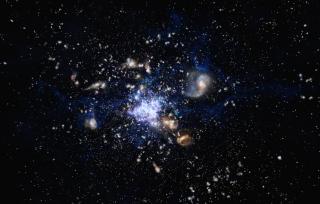Bibcode
Magdis, G. E.; Rigopoulou, D.; Daddi, E.; Bethermin, M.; Feruglio, C.; Sargent, M.; Dannerbauer, H.; Dickinson, M.; Elbaz, D.; Gomez Guijarro, C.; Huang, J.-S.; Toft, S.; Valentino, F.
Bibliographical reference
Astronomy and Astrophysics, Volume 603, id.A93, 9 pp.
Advertised on:
7
2017
Journal
Citations
58
Refereed citations
56
Description
We present millimetre dust emission measurements of two Lyman-break
galaxies at z 3 and construct for the first time fully sampled
infrared spectral energy distributions (SEDs), from mid-IR to the
Rayleigh-Jeans tail, of individually detected, unlensed, UV-selected,
main sequence (MS) galaxies at z = 3. The SED modelling of the two
sources confirms previous findings, based on stacked ensembles, of an
increasing mean radiation field ⟨ U ⟩ with redshift,
consistent with a rapidly decreasing gas metallicity in z> 2
galaxies. Complementing our study with CO[J = 3 → 2] emission line
observations, we have measured the molecular gas mass reservoir
(MH2) of the systems using three independent
approaches: 1) CO line observations; 2) the dust to gas mass ratio vs.
metallicity relation; and 3) a single band, dust emission flux on the
Rayleigh-Jeans side of the SED. All techniques return consistent
MH2 estimates within a factor of two or less,
yielding gas depletion time-scales (τdep ≈ 0.35 Gyr)
and gas-to-stellar mass ratios
(MH2/M∗ ≈ 0.5-1) for our z
3 massive MS galaxies. The overall properties of our galaxies are
consistent with trends and relations established at lower redshifts,
extending the apparent uniformity of star-forming galaxies over the last
11.5 billion years.
Herschel is an ESA space observatory with science instruments provided
by European-led Principal Investigator consortia and with important
participation from NASA.
Related projects

Molecular Gas and Dust in Galaxies Across Cosmic Time
Two of the most fundamental questions in astrophysics are the conversion of molecular gas into stars and how this physical process is a function of environments on all scales, ranging from planetary systems, stellar clusters, galaxies to galaxy clusters. The main goal of this internal project is to get insight into the formation and evolution of
Helmut
Dannerbauer